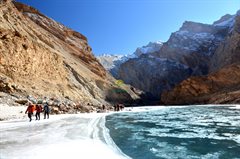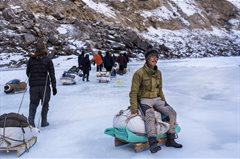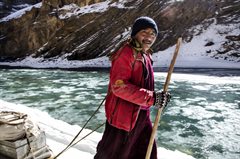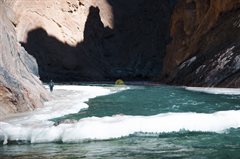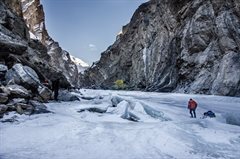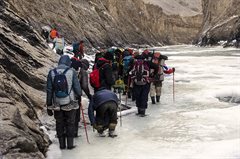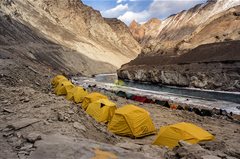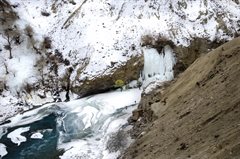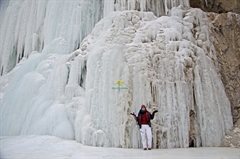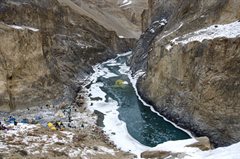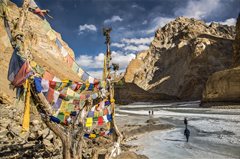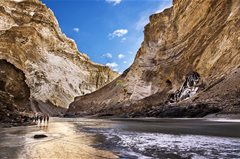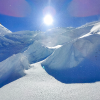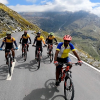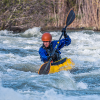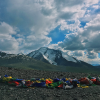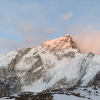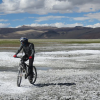Chadar - The Frozen River Trek
Walk on a Frozen River. Literally! / The ultimate Ice Walking Experience of Ladakh
Available Batches
Brief Description
Brief Itinerary
Detailed Itinerary
Day 1
Arrive in Leh (3,500 M)
The trek starts from Leh, which is a headway into Ladakh that is home to some of the highest peaks in the region. Because the roads are shut, the only way to get to Ladakh in winters is through air. There are flights that fly into Leh through Delhi and this two hour journey is where the magic begins. Try to get a window seat on the plane for the bird’s eye view of the Himalayas is absolutely mesmerizing.
Day one is reserved for you to make your way to Leh and get settled into your accommodation. Since you will be coming to this altitude from sea level, the body will need time to get comfortable with the altitude and the mountain air. Winters in Leh are quite harsh but the cold you experience here is only just the beginning!
Day 2
Rest and Acclimatization in Leh (3,500M)
Day two is reserved for rest and acclimatization to the altitude, too. This is important to allow your body to adapt to its new environment and reduce chances of adverse health conditions. You can go around and explore the city market, delve into the colors and culture of this high-mountain city and visit some places nearby. A little movement around the city would be good for acclimatization. Also, use this time to go through your checklist and do some last-minute shopping for what you might be missing for the trek. Leh has the best market for trekking essentials.
While the body acclimatizes, we take this time to get together with the group for a debriefing session where we get to know each other better and delve into the happenings of the next few days - schedule, what to expect, basic do's and don'ts in the mountains, how to maintain the sanctity of the environment and other such matters of importance.
Day 3
Rest and Acclimatization with Medical Test in Leh (3,500M)
Day 3 is also reserved to adapt to the cold winters of Leh. The only other thing on the agenda is a mandatory medical check-up at the Tourist Information Centre which is essential to obtain a NOC from ALTOA and a permit from the Wildlife Department to trek on Chadar.
Day 4
Drive from Leh (3,500M) to Tilado (3,215M) & trek to Shingra Yokma (3,300M)
Drive Distance: 70 kms, Trek Distance : 3-4 kms
Drive Duration: 2-3 hours , Trek Duration: 2-3 hours
Today is going to be our first actual day on Chadar – the first day when we trek in this winter wonderland. But not before we drive to Tilado which is the starting point of the trek. We start early in the morning to drive along the beautiful Indus River and past the confluence of Indus and Zanskar rivers at Nimmu. This short 70 km drive which should take close to 3 to 4 hours to cover, offers some of the most spectacular views as the vehicle goes around some narrow hairpin bends. As we inch closer to Tilado, we start to see the frozen marvel – Zanskar, waiting in all its glory. Once out of our vehicle and on the Chadar, the trek leaders will give you some quick tips on how to best manage yourself on this sheet of glassy ice. It will take a while to get a hang of it so don’t worry if you don’t get it right, right away – no one does. Walk around as much as you can using the Penguin Walk and you will soon find yourself giving tips to others.
The best thing about Chadar trek is that you walk on a flat surface throughout the trek. There are no steep ascents or descents and very little chance of catching AMS since you don’t gain any altitude throughout the trek. If you are comfortable today, you are already acclimatized and you should be able to finish the entire trek without any major issues.
Depending on the weather, the Chadar changes its forms. It can be hard and glass-like in some patches, or it can have a layer of powder snow on it giving you a better grip, or you could face thin ice in certain areas, so you might have to walk in slush or dodge that entire patch and go over the rocks on the side of the river. Walk together as a team and always follow the sledge route used by the porters as it is the safest route on Chadar.
We should reach the next campsite within 2-3 hours, depending on our speed and will spend our first official night camping on Chadar.
Day 5
Trek from Shingra Yokma to Shingra Koma (3,200M)
Distance: 7 kms
Duration: 5-6 hours
The hardest part from here on is getting out of the warm sleeping bag and your cozy tents to step out into the freezing cold. However, the people of Zanskar are known for their hospitality – you will always wake up to a hot cup of tea and a meal waiting for you - all of which makes waking up in subzero temperatures just a little bit easier.
Today is a day with 7 kilometers to our next campsite. Since walking on Chadar is not the easiest, this should take anywhere between 5-6 hours to cover. Remember to top up your thermos with warm water – regular water bottles cannot fight the cold of Chadar and the water tends to freeze up. Sunshine in this bend of the land is a scarce commodity as well. You will only see the sun for an hour or two on the trail and that too, in patches since the walking trail is fenced by giant mountains on both sides. Marvel at the views as you walk in this huge valley with nothing but pure crisp air and huge rocks on both sides. The color of the Zanskar river is a vibrant deep blue that matches the blue of the sky on a clear, sunny day. The trail also offers frozen waterfalls all along the way. We stop along the river to cook our meals so that we are not walking empty-bellied. Expect to reach the campsite by late afternoon.
Day 6
Shingra Koma to Tsomo Paldar (3,300M)
Distance: 5-6 kms
Duration: 5-6 hours
The sun makes an exit from the Zanskar Valley early and the only way to keep warm is to keep moving. The ice in various patches is broken in the middle of the frozen river, forming geometrical structures of various shapes and sizes, which are fascinating to see.
Day 7
Tsomo Paldar to Shingra Yokma (3,300M)
Distance: 12 kms
Duration: 7-8 hours
We start our journey back to where we came from. Today, we head back to Shingra Yokma campsite but nothing on Chadar is ever the same. If you think you know the route back and can predict the challenges for the day, you are in for a surprise. The frozen Zanskar river reacts to the slightest change in temperatures, and constantly keeps changing its form – hence, even though the trail is the same, it is different! Pay close attention to all the changing sounds as you walk on different kinds of surfaces – it is fascinating. Along the way, we see local porters wearing traditional woolen robes called ‘Gonchas’, with colourful beads around their neck and their traditional hats. It’s fascinating to see the locals negotiating the frozen river, as they seem to walk like the wind, absolutely comfortable with the slippery uneven icy surface. They greet you using the local phrase ‘Julley’ which is the Ladakhi term for hello/welcome. You might also catch a few locals singing traditional Ladakhi songs while pulling their sledges and enjoying the journey.
Day 8
Shingra Yokma to Tilado (3,300M) and drive to Leh (3,500M)
Drive Distance: 70 km, Trek Distance: 2 kms
Drive Duration: 3-4 hours, Trek Duration: 1-2 hours
For our last day of the trek, we head back to where we started from – and we’ve come a full circle. To reach Tilado, we should take 1-2 hours. The drive back to Leh should be close to 3-4 hours from there on. We stay the night at a hotel.
Nerak Waterfall : As per the guidelines for 2025, Nerak Waterfall will be allowed to visit only on Wednesday & Sunday & we will be visiting the same during our itnerary overlapping with the authorities timeline.
The itinerary can be changed based upon the guidelines from local authorities or due to sudden change in weather forecast or Chadar condition.
Day 9
Departure from Leh
The trek ends here. If you plan to stay for a few more days to explore the wonders of Ladakh, the article below might help start you off on what places to consider. Places that you must visit in Leh Ladakh
Like we indicated before, the weather on high-altitude is unpredictable as are many other conditions. We would suggest you keep spare days between the end of the trek and your travel arrangements to head back home.
What's Included
- Camping during the trek on twin sharing basis and hotel stay in- Leh on Day 1, Day 2, Day 3 and Day 8 on twin/triple sharing basis.
- Meals during the trek starting lunch on Day 4 till lunch on Day 8
- Trek equipment includes Dome Tents (twin sharing), Siachen sleeping bags, mattress
- Helmet, Gaiters, Harness & Carabiners as required
- Experienced & mountaineering certified trek Leader with first aid certification.
- Services of Guide, Cook and Support team
- Transport from leh to Road head and return
What's Not Included
- Meals during hotel stay in Leh
- Any expenses incurred on medical examination in Leh
- Gum Boots will not be provided by us. Please carry your own Gum Boots or buy the same in Leh.
- Inner Line Permit Fee
- Any kind of personal expenses
- Any kind of Outdoor Insurance
- Portage of personal luggage
- Anything not specifically mentioned under the head price Includes
- Altoa & Environmental / Wildlife Permit Fee. Approx Charge 6k to 8k to be paid on the spot to the authorities
Are you Eligible for this Adventure?
Climbing up to an altitude of 3,400M, Chadar - The Frozen River Trek is as challenging as it is beautiful. Although it does not involve too much of a gain in altitude, adapting to the extreme temperature which drops to as low as -30 degrees and walking on a frozen river for 9 days is what makes this trek difficult. It is perfect for someone with prior trekking experience looking to level up a notch!
BRS Level Required
This makes it mandatory for you to have high-altitude experience of preferably multiple treks marked at level 4 on the BRS. The altitude, the terrain and the nature of the climb demand a certain level of skill and a need for you to be aware of how your body reacts to the various features of a high altitude environment.
If you do not know what level of BRS trek would suit you best, worry not! Fill out this Form:
we will send you a progression chart to help you comfortably get out of your comfort zone in order to level up and ultimately reach your highest potential in the big, bad world of outdoor adventure.
Packing List
This is a list of essential items for individuals doing the trek with Bikat Adventures. This list contains only those items which the participants are required to bring with them. The list excludes those items which are provided by Bikat Adventures on the trek. We have divided the items into five categories. All the items in the list are essential except for those marked as optional.
Trekking Gear
- Ruck sack bag with rain cover. Qty -1
- Day Pack Bag - Recommended for treks with summit day
- Head Torch with spare Batteries. Qty -1
- U V protection sunglasses. Qty -1 Here is how you can choose the best sunglasses for trekking.
- Water Bottles: 2 bottles of 1 liter each
Footwear
- Non-skid, deep treaded, high-ankle trekking shoes Qty -1
- Pair of light weight Slipper/Sandals Qty -1
Clothing
- Quick Dry Warm lower or Track Pants. Qty - 2
- Full sleeves T-shirts/ Sweatshirts. 1 for every 2 days of trekking
- Pair of thick woolen socks. 1 pair for every two days of trekking
- Thermal Body warmer Upper & Lower. Qty-1
- Undergarments. Qty - 1 for every day of trekking
- Warm jacket closed at wrist & neck .Qty-1
- Full sleeves sweater. Qty -1
- Rain wear ( Jacket & Pants ) . Qty-1
- Pair of waterproof, warm gloves. Qty-1
- Woolen cap. Qty-1
- Sun shielding Hat. Qty -1
Toiletries
- Personal toiletries kit (Small Towel, Toilet paper, paper soap, Bar soap, toothbrush, toothpaste, cold cream, etc.)
- Sun screen lotion small pack. Qty -1 Here is your Sun Protection 101 to stay safe in the bright sunny outdoors.
- Lip Balm small pack. Qty-1
Utensils
- Small size, Light weight & Leak proof lunch box. Qty-1
- Plate. Qty- 1
- Spoon.Qty-1
- Tea/Coffee (plastic) Mug.Qty-1
Miscellaneous
- Camera (Optional)
- Carry your medicines in plenty in case you have any specific ailment. Consult your doctor before joining the trek.
- Dry fruits, Nuts, Chocolate bars (Optional)
Frequently Asked Questions
Why Bikat?
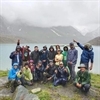

Small Group Size
Our batch sizes are capped at 15 for smaller treks with the trek leader and trekker ratio of 1:8. This ratio, in our years of experience, has proven to deliver the best trekking experience for individuals as well as groups. Capping the size of the group ensures individual attention to each trekker so that no signs of distress or need during the trek go unnoticed. It also helps to form a more cohesive cohort with better group energy which helps define the rhythm and pace of days on the trek. As you go higher up on the BRS scale, since the stakes are higher, expeditions have an even smaller group size with the ratio of expedition leader to climber set at 1:2.
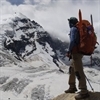

Qualified Trek Leaders
We follow a rigorous regime of hiring and training our experts in the field. Each trek leader is a certified mountaineer with years of experience in the field. In addition to their qualification, they also go through practical and situational training to tackle any and all kinds of sudden conditions that may present themselves on the ground. Being unpredictable is the core nature of the mountains but being ready for any circumstance as best as possible is a controllable asset that we try to nurture. Our field experts are also trained in basic medicine and first-aid response. Watch: Forerunners - The Making of A Trek Leader At Bikat Adventures
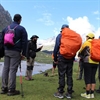

Guided Progression
Since Bikat Adventures is a learning-based organization, we help you climb up the ladder of difficulty within the sphere of outdoor adventure systematically. Our on-ground training modules are designed to handhold you through the upskilling process so that you are ready to take on bigger challenges.
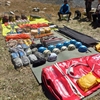

Equipment Quality and Check
All the gear used on our treks and expeditions is tried and tested, maintained for good quality, and is overall top-notch in quality and condition. We are continually looking to obtain the best of everything there is in the market so as to ensure optimum safety.
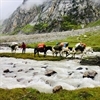

Support Systems
Along with the staff you see on-ground, we have a team of superheroes working in the background to give you the best experience possible. Our background team also comprises local staff from each area who know the region best. Having local support helps with studying the area, pre-planning, execution, and in receiving timely support in case of emergencies in these remote locations.
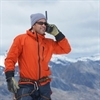

Communication
Our on-field staff is in constant contact with our teams based in primary locations so as to eliminate any avoidable delay in reaching additional help and support when required. We try to use the best tools for communication available, including satellite phones, in regions where they are not restricted.
What our customers Say
Cancellation Policy
Cash refund
Cancellations up to 60 days prior to departure date
Between 60 days upto 30 days prior to departure date
Between 30 days upto 10 days prior to departure date
Less than 10 days prior to departure date
Voucher refund
Cancellations up to 30 days prior to departure date
Between 30 days upto 15 days prior to departure date
Between 15 days upto 10 days prior to departure date
Less 10 days prior to departure date
- Cash refund is applicable only in case of bookings made without using any promotional offer code or Cancellation Vouchers or Discounts
- This is only a brief of cancellation terms. For finer details please refer Detailed Cancellation Policy.
Blog Posts
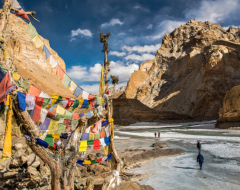
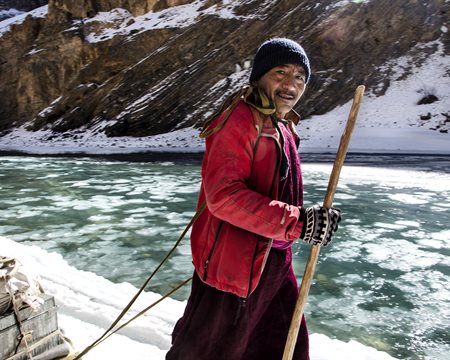

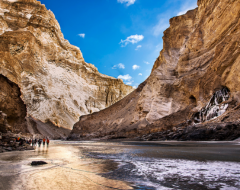
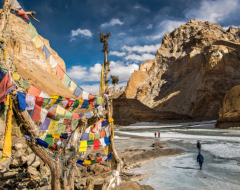
Similar Adventures

Sumda Chey Winter Trek
A mystical winter trek where adventure meets culture
Ladakh
9 days
BRS 5
4541 m
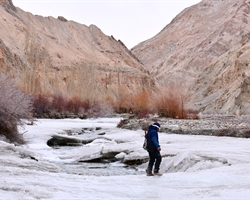
Markha Valley Winter Trek
Ladakh
10 Days
BRS 4
4050 m
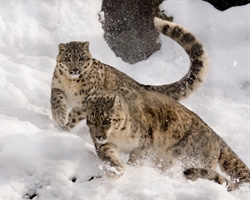
Snow Leopard Trek - Spiti
Trekked by Many, Discovered by a Handful
Himachal
9 Days
BRS 4
4400 m
